|
Sake : The drink of the God |
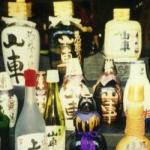 Sake is the famous traditional rice wine of Japan ,which has played an integral role in the Shinto religion and japanese life and culture about 2,000 years
"Sake : The drink of the God" Sake is the famous traditional rice wine of Japan ,which has played an integral role in the Shinto religion and japanese life and culture about 2,000 years
"Sake : The drink of the God"
|
Next beverage is for everyone interested in Japanese drink .
Yes, we'll be bringing you to be drunk with Sake ,the drink for forget the year party (bounenkai)
| |
| Relax yourself and enjoy with us !
|
|
Sake is the famous traditional rice wine of Japan ,which has played an integral role in the Shinto religion and japanese life and culture about 2,000 years.
Historically, Sake was first found in China,but it was the japanese who began mass production of this simple.The Japanese began producing sake
sometime after the introduction of wet rice cultivation in the third century B.C.In ancient Japan, sake production was confined
primarily to the Imperial court and to large temples and shrines.
That's why sake is often associated with religious rituals and festivals. Even today, sake is always served at traditional ceremonies in Japan.
|
|
There are four basic ingredients in making sake. |
|
The first and perhaps most important is rice. Sake rice is selected because it is has a larger kernel, and
also because it is easier to work with than other grains. Sake production process begins with "polishing" or milling the rice kernels,
which were then cooked in good, clean water and made into a mash" . |
| |
Interestingly the milling process was once completed by hand, or rather by mouth. In the former times , sake production saw
"chewing parties" as part of a Shinto fertility rite: a whole village would chew the grains of rice and nuts and then spit the chewed product
into a communal tub.It was called "kuchikami no sake," which is Japanese for "chewing the mouth sake.
" It was believe that the chewing process could introduce the enzymes necessary for fermentation. | |
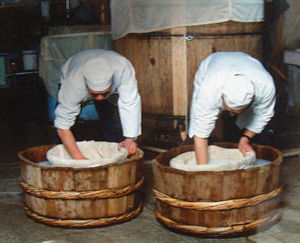 | |
| |
Although that method was part of a Shinto religious ceremony, it was discontinued when people knew that Koji (a mold enzyme) and
yeast could be added to the rice to start the fermentation process.
The polished rice is then steamed, and "koji" (a yellow mold that is grow very carefully by the brewmaster (toji)
in a dark place) is scattered folded into the steamed rice. The koji grows on the steamed rice, and converts the starch into sugar. |
|
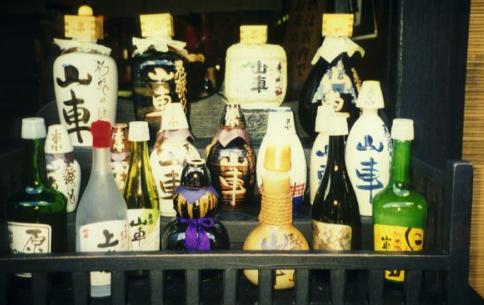 | |
| |
Yeast and water are then added to the mixture, and the quality of both of these ingredients plays a major role in determining
both taste and quality. The yeast most commonly used is known as Saccaromyces cerevisiae, but the experienced toji often experiment with other types of yeast.
The type of water used ranges from mountain spring water to desalinated water from the ocean – the important factor in both is mineral content,
and of course water that has not had chemicals like fluoride added is essential. |
|
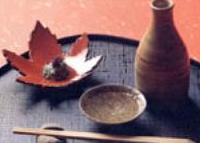 | |
| |
The mixture of yeast, rice, koji, and water is then allowed to ferment for
between 18 to 35 days. The temperature the mash is kept at helps to determine the strength and dryness of the sake produced.
After the mixture has fermented, it is "pressed" to separate the liquid from the mash..
In the twentieth century, a press replaced the traditional canvas bags for squeezing the liquid out of the bag, although some sake is still brewed the old-fashioned way. The extracted liquid is then filtered, and is often pasteurized to kill off unwanted bacteria. Most sake is then aged for up to six months to increase its potency and flavor, and then more water is added to increase the yield and lessen the alcoholic content.
The resulting product is then sold to the consumer, and can be served alone or in cocktails. Most sake is best consumed fresh, rather than
leaving it to age any further. It is an ideal beverage to accompany almost any of the world's cuisines, regardless of the ingredients of style of
preparation. That's why it's often served at French and Italian restaurants in Japan |
|
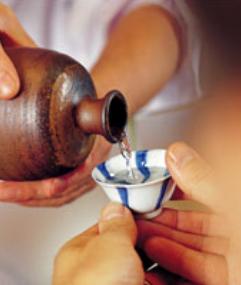 | |
|
Sake can be classified into the following four varieties in terms of taste and aroma.
|
|
- Flavorful sake Sake with a fruity, flowery aroma and low acidity
- Light, smooth sake Sake with a fresh taste, moderate acidity and dry aftertaste
- Rich sake Sake with a light mild flavor and rich,smooth taste
- Aged sake Sake with a light golden color, a spicy, nutty taste and a flavor reminiscent of sherry.
|
|
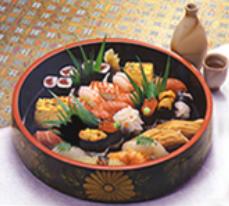 | |
|
Remember that ,from its earliest beginnings sake has been a drink of reverence, family, and friendship, consumed to mark important occasions.
Because it is meant to be enjoyed with friends and family, tradition holds that a person must never pour their own sake; instead another person
pours for you, and you do the same for them. For thousands of years sake has been a major part of Japanese life,
and its popularity is now increasing on the international stage.
|
Nam Khing
| Source: | www.asianartmall.com |
| www.japansake.or.jp |
| www.sake.com |
|
|